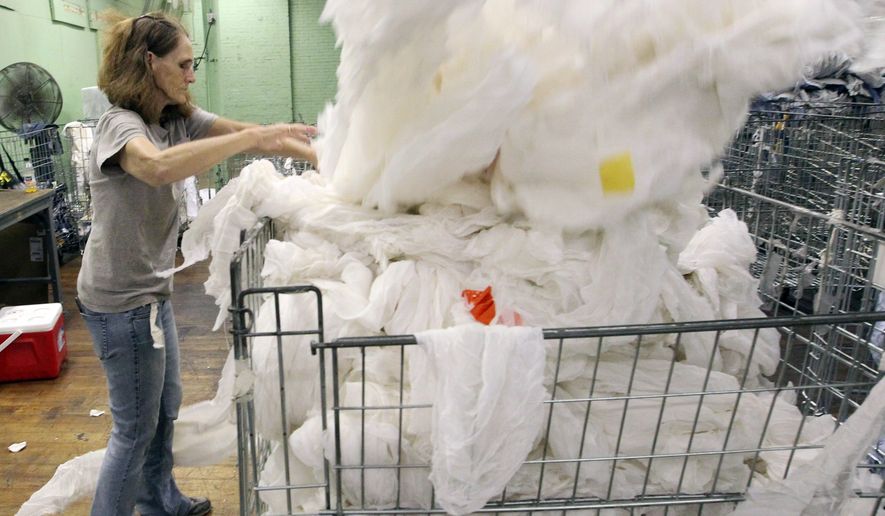U.S. economic growth barreled ahead at a brisk 3.5 percent rate this summer, exhibiting the best momentum in more than a decade and suggesting it has finally broken out of the doldrums after five years of sluggish recovery.
The Commerce Department’s report Thursday on the gross domestic product is the last major news on the economy before the midterm elections. The strong showing follows an even more robust 4.6 percent surge in the spring as the economy rebounded from an unusual winter slump.
The past six months of growth were the best since 2003 and were accompanied by an upswing in jobs that has sent the unemployment rate below 6 percent for the first time this decade.
A separate report Thursday from the Labor Department showed the monthly average of weekly jobless claims fell to a 14-year low as employers held on to their existing workforces and sought out new hires.
“The economy showed its true color: moderate but sustained growth,” said Sung Won Sohn, an economics professor at California State University Channel Islands. “On the heels of weather-beaten first quarter, the economy has rebounded nicely. … The train has left the station and will be traveling at a steady pace of about 3 percent for a foreseeable future.”
U.S. markets, also bolstered by strong corporate earnings reports, rallied sharply after the latest U.S. figures were released. The Dow Jones industrial average rose 221.11 points, or 1.30 percent, to 17,195.42. The S&P 500 gained 12.35 points, or 0.62 percent, to 1,994.65. The Nasdaq composite added 16.91 points, or 0.37 percent, to 4,566.14.
This summer’s growth spurt was led by surging exports, business investment and government spending, which increased by 7.8 percent, 5.5 percent and 4.6 percent, respectively, the department reported. Defense spending jumped by 16 percent, the most in five years.
Consumer spending rose a more subdued 1.8 percent, although consumers splurged on big-ticket items such as cars and appliances.
“The economy keeps motoring along,” putting in a “very healthy” performance, said Justin Wolfers, an economics professor at the University of Michigan.
While a one-time surge in defense and other government spending contributed nearly 1 percentage point to the growth rate, he said, the liquidation of business inventories subtracted more than a half-point from growth, so they “canceled each other out.”
“Underlying growth remains solid,” he said. The surge in exports, while showing the U.S. remains competitive in a slowing global economy, is not likely to be repeated because of sluggish growth in Europe, China and other major trading partners, he said.
The White House seized on the GDP report, noting that many leading U.S. trade partners are barely growing. President Obama’s top economic adviser argued that Democratic priorities — such as a hike in the nation’s minimum wage and the enactment of equal pay laws — would accelerate growth even more.
The latest numbers “highlight that the United States is continuing to lead the global recovery,” said Jason Furman, chairman of the White House Council of Economic Advisers. “Nevertheless, more must still be done to boost growth both in the United States and around the world by investing in infrastructure, manufacturing and innovation, and to ensure that workers are feeling the benefits of that growth by pushing to raise the minimum wage and supporting equal pay.”
The export surge and defense spending spurt are not likely to be repeated, but the sluggish pace of consumer spending leaves room for improvement, said Doug Handler, chief U.S. economist at IHS Global Insight.
“The full impact of lower gasoline prices is not yet evident in the data,” he said. The average price of gasoline has dropped dramatically in the past month to below $3 a gallon in many areas, giving a boost to consumer discretionary income, confidence and purchasing power.
“Consumers’ nominal spending on gasoline fell by $7 billion in the third quarter,” said Mr. Handler. “This savings is available to be spent on other goods and services. … We expect this benefit to be larger in the fourth quarter and disproportionately accrue to lower- and middle-income consumers who spend larger shares of their income on gasoline.”
With a lower gas prices, he said, “we believe there is room for improvement in this underlying growth. Generally favorable employment and interest rate conditions warrant a faster pace of consumer and business spending. But this growth will be moderated by a rising U.S. dollar and poor economic growth outside of the U.S.”
⦁ Ben Wolfgang contributed to this report.
• Patrice Hill can be reached at phill@washingtontimes.com.




Please read our comment policy before commenting.